AMD FX-8120, AMD FX-6100 and AMD FX-4100 CPUs Review

We will talk about the mainstream and entry-level AMD FX CPU modifications based on Bulldozer microarchitecture and featuring eight-, six- and four-core design.
New Bulldozer processor microarchitecture introduced by AMD two months ago made a very weak impression and turned out a major disappointment for many of us. The performance of the flagship eight-core CPU based on it, the FX-8150, proved to be not only lower than that of the competing quad-core Intel Core i5 and Intel Core i7 LGA 1155 processors, but sometimes even lower than that of AMD’s own six-core Phenom II X6. Nevertheless, despite disastrous performance numbers in comparative tests, the manufacturer has no intention to give up this microarchitecture. It has not only settled in the contemporary desktop and server AMD CPUs, but will be also used later on in the upcoming next-generation products, such as traditional CPUs as well as hybrid APUs.
Even though Bulldozer doesn’t looks like a significant step forward from the consumer standpoint, it still gives AMD engineers room for optimizations and enhancements. The old K10 microarchitecture has been obviously squeezed dry by now. For example, as we can see from Llano processors, even the transition to 32 nm process doesn’t have any positive effect anymore. Therefore, AMD bet on Bulldozer in the attempt to adapt new production technology for all types of products. In fact, the production of Bulldozer based processors is more profitable than the production of the six-core Phenom II X6 CPUs, which have a larger semiconductor die.
The old 45 nm processors from Phenom II and Athlon II families are literally living out their last days. AMD will only accept orders for these processors until the end of this year and after that they will be considered outdated. Instead, the company will offer either hybrid A-series Llano processors, or different FX CPU modifications with Bulldozer microarchitecture, which will become much more numerous by then.
It is quite logical that the FX processor family coming to replace Phenom II should be at least as versatile as the latter. Although Bulldozer has eight-core structure, the processor family should also include many modifications with fewer computational cores. Therefore, it is not surprising that in AMD will be in vesting a lot of time and effort in expanding the FX lineup, so that by early 2012 we could have the following desktop variety available to us:
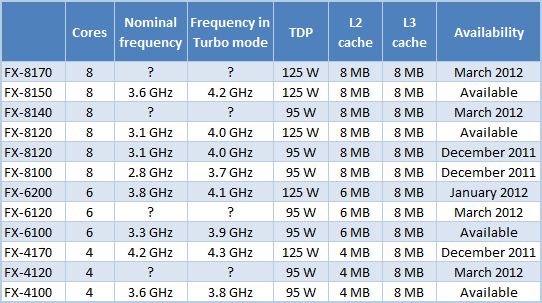
Will the Bulldozer modifications with four and six computational cores be able to successfully replace Phenom II? Taking into account the performance numbers demonstrated by the eight-core FX-8150 processors in our earlier test session, it may be very difficult to definitively answer this question. But luckily, the first quad- and six-core Bulldozer processors already made their way to the stores that is why we took the opportunity to investigate the performance of the junior AMD FX CPU models, which we are happy to share with you today.
Four Cores Out Of Eight
Well, today’ we are going to talk primarily about the junior processors on Bulldozer microarchitecture: FX-8120, FX-6100 and FX-4100. The very first one of the three differs from the previously reviewed FX-8150 only by its lower clock frequency. FX-6100 and FX-4100 seem to be much more interesting products, because they have six and four computational cores inside instead of Bulldozer’s typical eight-core structure.
In fact, the first question that arises when we meet FX-6100 and FX-4100 processors is: what semiconductor die really is inside them. AMD has always been for unification, and this time is also no exception. All FX processors use the same semiconductor die with eight physical cores. The modifications with fewer cores are created by simply disabling certain parts of the die.
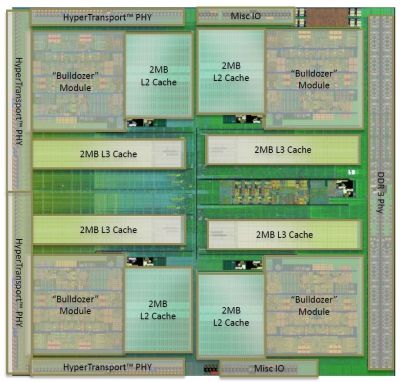
However unfortunately for many of us, they no longer use the same approach to disabling parts of the die, as in Phenom II and Athlon II: it is now performed at low-hardware level. You won’t be able to play the same trick on Bulldozer processors: there is absolutely no way to unlock the cores disabled by the manufacturer. In other words, if you are buying, for example, a quad-core processor, you won’t be able to turn it into a six- or eight-core one.
Another frustrating peculiarity is that AMD disables pairs of cores on the per-module basis. Since two cores inside the same module share a lot of resources, including instruction prefetch and decoding units, floating point unit and L2 cache, it would make much more sense from performance standpoint to disable only one core per module. Unfortunately, this approach was not only difficult to implement, but would also make it impossible for AMD to put their defective dies to good use in quad-c and six-core processors. Therefore, this strategy has never been utilized that is why the theoretical performance of the quad-core Bulldozer processors is exactly half of what their fully-functional brother is capable of.
To back up our statements we decided to use a quad-core Bulldozer processor to replicate two possible ways of disabling CPU cores and compare the performance in both cases. In the first case we used a “real” FX-4100 with two modules and four cores, and in the second – an eight-core four-module Bulldozer where we manually disabled one core per module. To ensure that the comparison is fair, we set the clock frequency to 3.6 GHz for both processors. For your reference we also included the performance numbers of a fully-functional eight-core CPU with all cores active and running.

As we have expected, disabling one core per module leads to higher overall performance than in case two of the four modules are completely disabled, although in both cases the number of active cores is formally the same. And I have to stress that the performance difference is more than noticeable and may reach 25% in some cases. This is what you could gain if the microarchitectural resources shared between the cores within one processor module will be allocated fully to one single core. Unfortunately, they never implemented this approach that is why quad-core (and six-core AMD FX processors have the same exact internal organization as their elder brothers, i.e. contain pairs of cores.
The good news is that all CPU modifications in the FX series retain 8 MB of L3 cache. Although the cache itself is segmented and allows us to disable parts of it, even the very junior quad-core Bulldozer modifications have the same L3 cache as the top processors with eight computational cores.
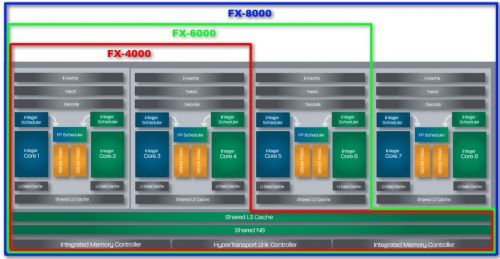
Closer Look at FX-8120, FX-6100 and FX-4100
Besides the top FX-8150 processor, there are three more FX CPUs available today: FX-8120, FX-6100 and FX-4100.
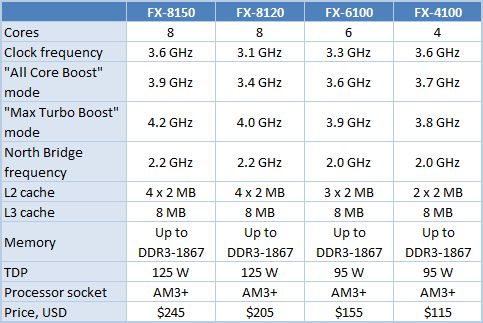
We had the opportunity to test all four processors that is why besides the official specifications we can also offer you CPU-Z screenshots:
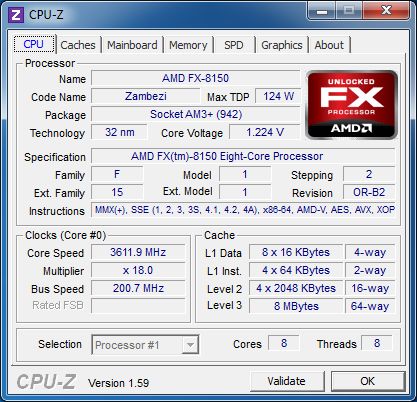
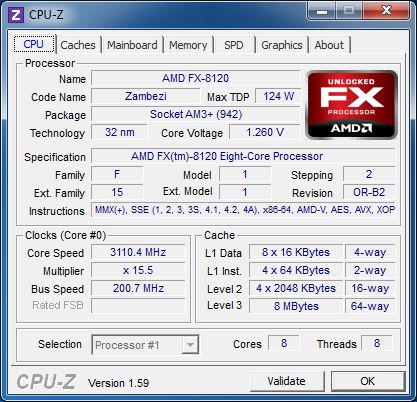
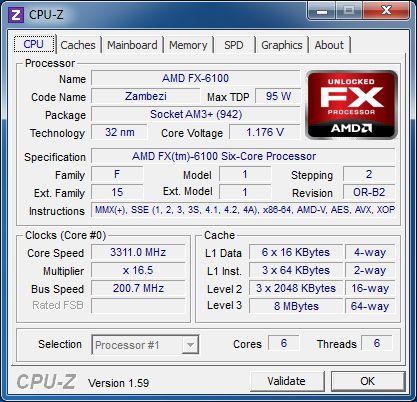
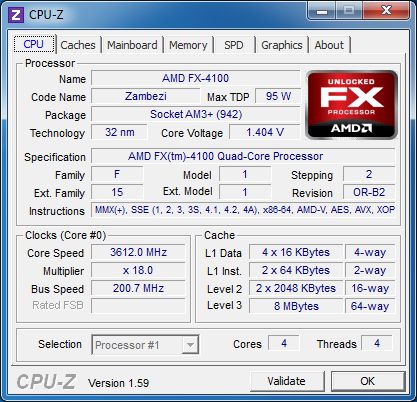
All CPUs use the same B2 processor stepping and they differ by the number of active modules/cores, clock frequency and TDP. Both eight-core processors belong to 125 W thermal envelope, FX-6100 and FX-4100 are more energy-efficient and their TDP is set at 95 W. I would like to point out that eight-core processors will not always have higher TDP than the rest of the models. Very soon AMD is going to release their FX-8000 series models with 95 W TDP. They will most likely be built on the new B3 processor stepping, which will be designed to lower Bulldozer’s thermal and energy appetites.
The eight- as well as six-core FX processors have two-step Turbo mode. The first step called “All Core Boost” allows increasing the processor clock frequency even if all cores are utilized, but the processor’s heat dissipation and power consumption remain thin acceptable limits. The second step called “Max Turbo Boost” allows increasing the frequency when no more than half of all the cores are utilized. As you can see from the table above, All Core Boost may increase the CPU clock speed only by 100-300 MHz, while Max Turbo Boost offers much more dramatic automatic overclocking. However, Turbo mode will have real practical value only for eight and six-core CPUs models. As for quad-core Bulldozer based processors, they have seriously limited automatic overclocking potential and its benefits will be barely noticeable.
Moreover, another thing that makes six- and quad-core FX processors inferior to their eight-core brothers is the North Bridge frequency. AMD’s lower-cost CPU models with fewer cores have this frequency lowered by 10%, which in its turn affects the memory and L3 cache performance. We can see the practical repercussions of this change in the AIDA64 cache & Memory Benchmark, which estimates the practical bandwidth and latency of the memory sub-system. For an even more illustrative picture we ran this test on FX-8150 and FX-4100 processor working at the same 3.6 GHz clock frequency with DDR3-1867 SDRAM with 9-11-9-27 timings.
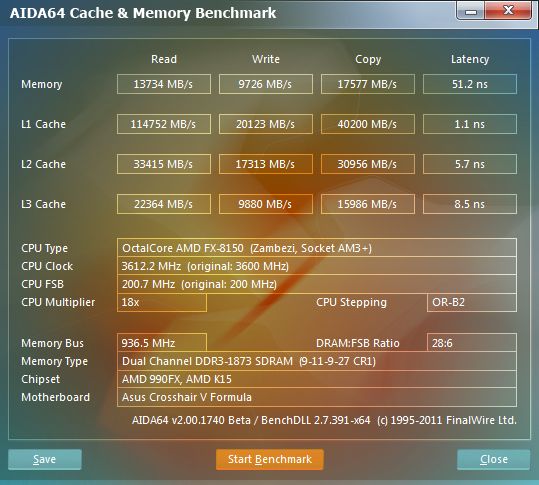
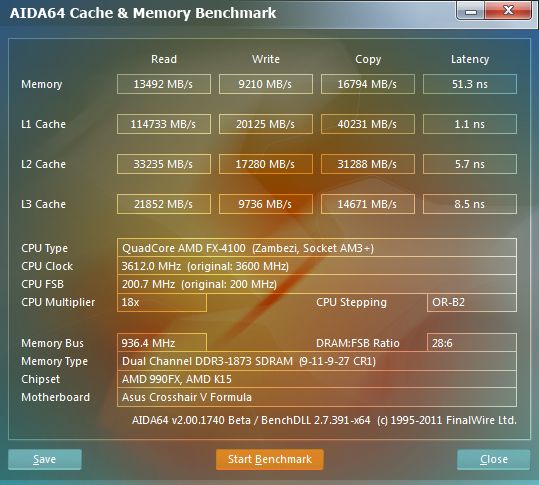
We do see slight difference in actual memory speed and L3 cache performance by different Bulldozer modifications, but it is not critical at all. Moreover, we shouldn’t forget that all FX processors are Black Edition ones. It means that the multipliers for the clock frequency and the frequency of the built-in North Bridge are unlocked, which gives the users freedom to configure and easily overclock their processors. Some mainboards take advantage of this AMD FX feature and by default set the processor North Bridge frequency to 2.2 GHz for all Bulldozer CPUs.
Testbed Configuration and Testing Methodology
By launching several different desktop Bulldozer modifications with various number of computational cores, AMD is putting up a very wide front. All four contemporary FX processors have such different prices that they can be classified as belonging to completely different price categories. Therefore, we had to include a pretty vast number of competing products in our performance comparison featuring X-8150, FX-8120, FX-6100 and FX-4100 processors.
We are going to compare the eight-core desktop Bulldozer against a six-core Phenom II X6 1100T and top LGA 1155 quad-core processor from the Core i5 series. FX-6100 will be competing against mainstream Phenom II X6 and junior Core i5 CPUs. The price of FX-4100 suggests that we have to compare it against Phenom II X4 and Core i3 CPUs.
However, AMD is known for their flexible pricing, and this seems to be exactly the case with the new FX processors. AMD’s marketing professionals tried to come up with such prices for the new Bulldozer products, which could make it fairly difficult to find a direct competitor for them in the Sandy Bridge camp. Only two AMD processors out of four discussed in this article have direct Intel rivals. FX-8120 is priced just like Core i5-2500, while FX-4100 is set against Core i3-2120. The other two processors, AMD FX-8150 and FX-6100, have been priced in such a way that they fall in-between Core i7 and Core i5 or Core i5 and Core i3, respectively.
As a result, we ended up using the following hardware and software components during our test session:
- Processors:
- AMD FX-8150 (Zambezi, 8 cores, 3.6/4.2 GHz, 8 MB L2 + 8 MB L3);
- AMD FX-8120 (Zambezi, 8 cores, 3.1/4.0 GHz, 8 MB L2 + 8 MB L3);
- AMD FX-6100 (Zambezi, 6 cores, 3.3/3.9 GHz, 6 MB L2 + 8 MB L3);
- AMD FX-4100 (Zambezi, 4 cores, 3.6/3.8 GHz, 4 MB L2 + 8 MB L3);
- AMD Phenom II X6 1100T (Thuban, 6 cores, 3.3/3.7 GHz, 3 MB L2 + 6 MB L3);
- AMD Phenom II X6 1075T (Thuban, 6 cores, 3.0/3.5 GHz, 3 M? L2 + 6 MB L3);
- AMD Phenom II X4 955 (Deneb, 4 cores, 3.2 GHz, 2 MB L2 + 6 MB L3);
- Intel Core i5-2500K (Sandy Bridge, 4 cores, 3.3/3.7 GHz, 1 MB L2 + 6 MB L3);
- Intel Core i5-2320 (Sandy Bridge, 4 cores, 3.0/3.3 GHz, 1 MB L2 + 6 MB L3);
- Intel Core i3-2120 (Sandy Bridge, 2 cores + HT, 3.3 GHz, 0.5 MB L2 + 3 MB L3);
- Intel Pentium G860 (Sandy Bridge, 2 cores, 3.0 GHz, 0.5 MB L2 + 3 MB L3).
- CPU cooler: NZXT Havik 140;
- Mainboards:
- ASUS Crosshair V Formula (Socket AM3+, AMD 990FX + SB950);
- ASUS P8Z68-V PRO (LGA1155, Intel Z68 Express).
- Memory:
- 2 x 4 GB, DDR3-1866 SDRAM, 9-11-9-27 (Kingston KHX1866C9D3K2/8GX) – with AMD FX and Intel Core i5 processors;
- 2 x 4 GB, DDR3-1600 SDRAM, 9-9-9-24 (Kingston KHX1866C9D3K2/8GX) – with AMD Phenom II, Intel Core i3 and Intel Pentium processors.
- Graphics card: ATI Radeon HD 6970.
- Drive: Crucial m4 256 GB (CT256M4SSD2).
- Power supply unit: Tagan TG880-U33II (880 W).
- Operating system: Microsoft Windows 7 SP1 Ultimate x64.
- Drivers:
- Intel Chipset Driver 9.2.0.1030;
- Intel Management Engine Driver 7.1.10.1065;
- Intel Rapid Storage Technology 10.8.0.1003;
- AMD Catalyst 11.11 Display Driver.
Unfortunately, we are still unable to include an update for the Windows 7 OS scheduler into the list of utilized software applications, which should allow to optimally distribute the computational threads among the cores inside the processor modules. In the meantime, the above mentioned patch is indeed in the works and, according to AMD officials, should be available in the near future. The use of this patch is expected to boost the performance of AMD FX based platforms by 5-10%.
Performance
General Performance
As usual, we use Bapco SYSmark 2012 suite to estimate the processor performance in general-purpose tasks. It emulates the usage models in popular office and digital content creation and processing applications. The idea behind this test is fairly simple: it produces a single score characterized the average computer performance.
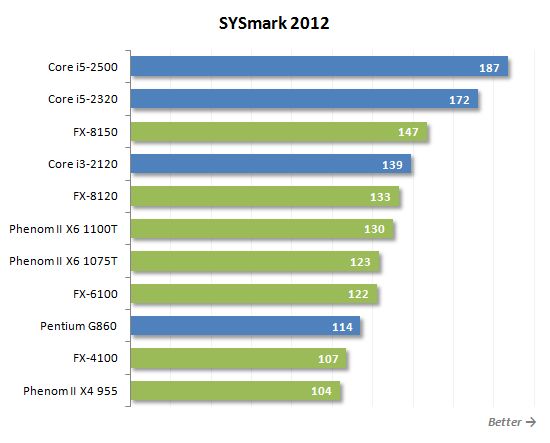
We already know since our AMD FX-8150 review that Bulldozer based processors do not do too well in performance tests for general-purpose applications. Multi-core microarchitecture of the new AMD CPUs is well adapted for work with heavy parallel loads, but the individual CPU cores show not very high performance numbers. At the same time, only a few selected applications call for prominent multi-threading that is why the overall picture doesn’t look too good for new AMD processors. Eight-core FX-8150 and FX-8120 yield to quad-core Core i5 CPUs. Moreover, the junior eight-core AMD processor loses even to the dual-core Core i3-2120. The performance of the six-core FX-6100 falls between Core i3 and Pentium, while the youngest desktop Bulldozer, FX-4100, yields even to the low-end Pentium G860.
If we look at the performance of the new AMD CPUs against the background of their predecessors, we can say that quad-core FX-4100 belongs to the same group as quad-core Phenom II X4, the six-core FX-6100 is about as fast as the mainstream six-core Phenom II X6, and the eight-core FX-8120 and FX-8150 quite logically continue the best there is in the Phenom II family. All this doesn’t really correlate that well with the current Bulldozer prices, which in this case seem a little over the top, but AMD believes that theoretical innovation of their multi-core microarchitecture will make up for the lack of remarkable practical results.
Let’s take a closer look at the performance scores SYSmark 2012 generates in different usage scenarios.
Office Productivity scenario emulates typical office tasks, such as text editing, electronic tables processing, email and Internet surfing. This scenario uses the following applications: ABBYY FineReader Pro 10.0, Adobe Acrobat Pro 9, Adobe Flash Player 10.1, Microsoft Excel 2010, Microsoft Internet Explorer 9, Microsoft Outlook 2010, Microsoft PowerPoint 2010, Microsoft Word 2010 and WinZip Pro 14.5.
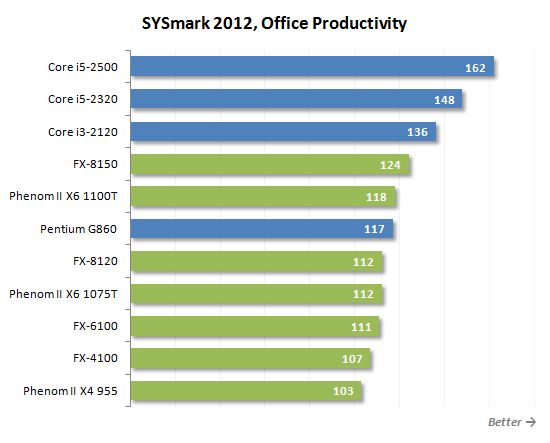
Media Creation scenario emulates the creation of a video clip using previously taken digital images and videos. Here they use popular Adobe suites: Photoshop CS5 Extended, Premiere Pro CS5 and After Effects CS5.
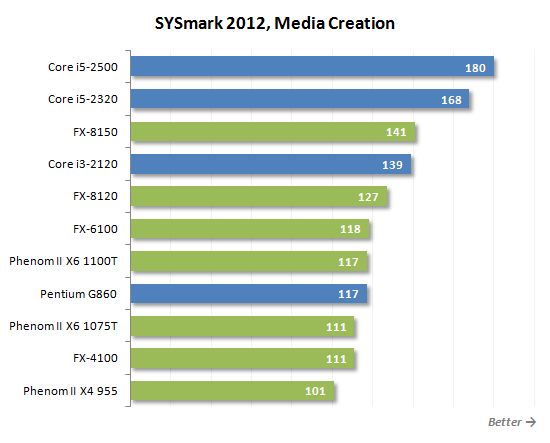
Web Development is a scenario emulating web-site designing. It uses the following applications: Adobe Photoshop CS5 Extended, Adobe Premiere Pro CS5, Adobe Dreamweaver CS5, Mozilla Firefox 3.6.8 and Microsoft Internet Explorer 9.
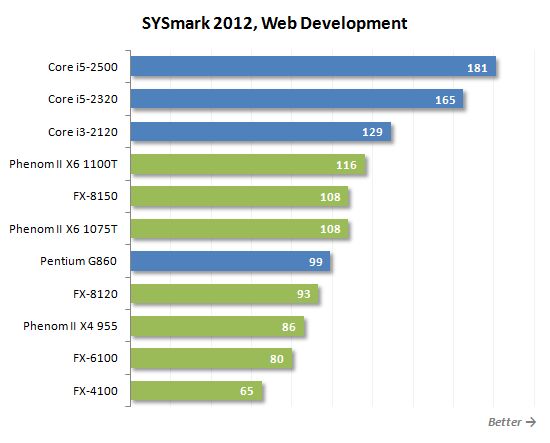
Data/Financial Analysis scenario is devoted to statistical analysis and prediction of market trends performed in Microsoft Excel 2010.
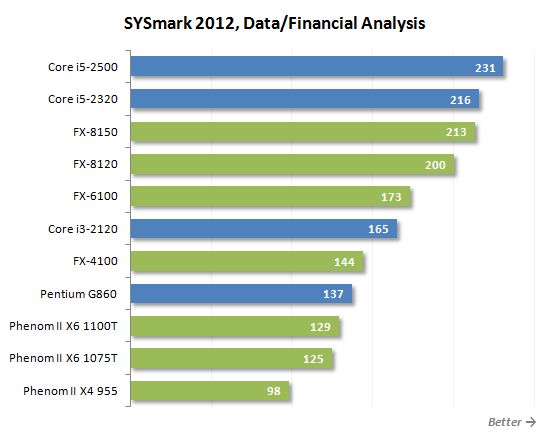
3D Modeling scenario is fully dedicated to 3D objects and rendering of static and dynamic scenes using Adobe Photoshop CS5 Extended, Autodesk 3ds Max 2011, Autodesk AutoCAD 2011 and Google SketchUp Pro 8.
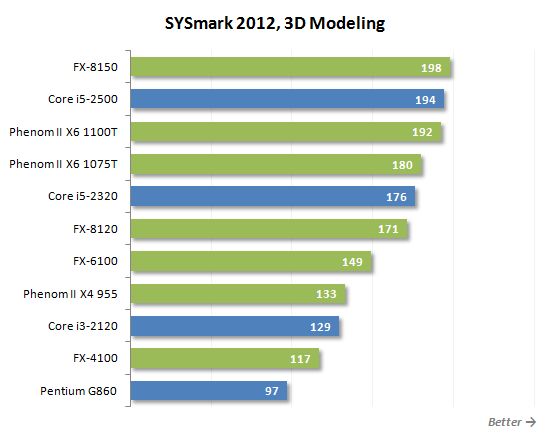
The last scenario called System Management creates backups and installs software and updates. It involves several different versions of Mozilla Firefox Installer and WinZip Pro 14.5.
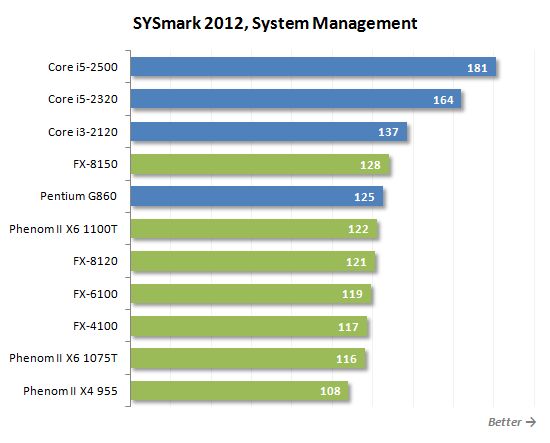
Out of six scenarios, the new AMD FX processors do well only in one: during 3D modeling and rendering. It is actually not surprising, because in tasks like that the number of cores matters a lot. But even in the most favorable case eight Bulldozer cores are equivalent to four Sandy Bridge cores and the six-core FX-6100 loses even to Core o5-2320.
In other wide spread applications including popular tools for creating and editing multimedia content, AMD processors look even sadder. Bulldozer microarchitecture should totally stay away from office applications and Web-development tools.
Gaming Performance
As you know, it is the graphics subsystem that determines the performance of the entire platform equipped with pretty high-speed processors in the majority of contemporary games. Therefore, we do our best to make sure that the graphics card is not loaded too heavily during the test session: we select the most CPU-dependent tests and all tests are performed without antialiasing and in far not the highest screen resolutions. In other words, obtained results allow us to analyze not that much the fps rate that can be achieved in systems equipped with contemporary graphics accelerators, but rather how well contemporary processors can cope with gaming workload. Therefore, the results help us determine how the tested CPUs will behave in the nearest future, when new faster graphics card models will be widely available.
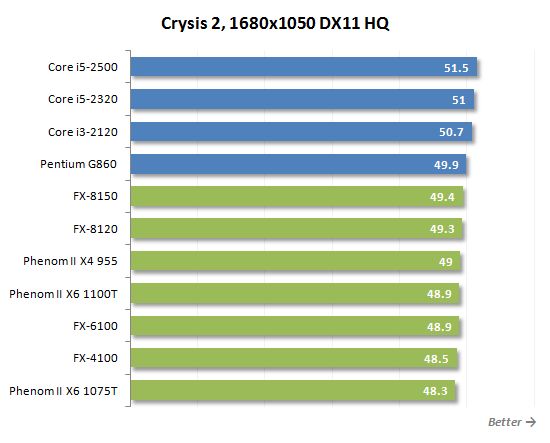
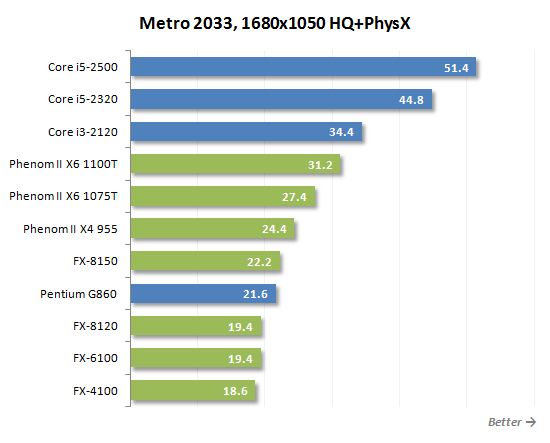
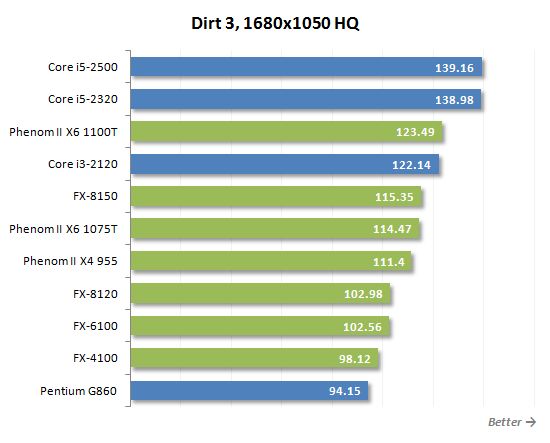
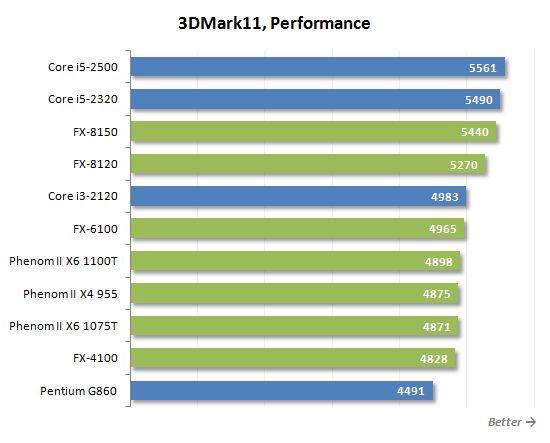
AMD FX processors are definitely not cut for gaming. They not only get completely destroyed by Intel’s Core i5 and Core i3, but also yield even to their own predecessors from the Phenom II family. The reasons behind this situation are quite obvious: contemporary games can rarely take full advantage of the multi-core architectures, so the real strength of the new Bulldozer microarchitecture remains in the shade.
In addition to our gaming tests we would also like to offer you the results of the Futuremark 3DMark11 benchmark (Performance profile):
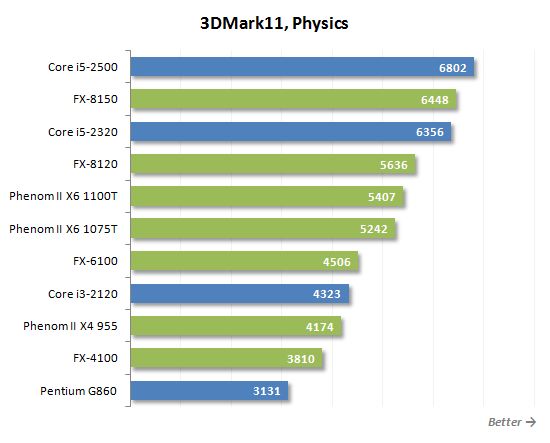
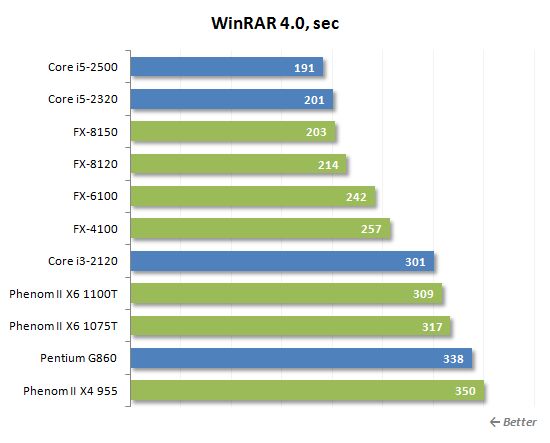
In the meanwhile, Bulldozer’s results in the synthetic 3DMark11 are not that bad at all. This test uses multi-threading, that is why eight- and six-core AMD FX processors manage to break away from their predecessors. The fastest pair, FX-8150 and FX-8120, even manage to outperform their dual-core Core i3 competitor. The six-core FX-6100 in this case performs as fast as Core i3-2120, and the quad-core FX-4100 surpasses Pentium G860. In other words, if the prices of the new AMD FX processors were about 1/3 lower, their 3DMark11 results could be considered adequate.
Performance in Applications
Overall, the general purpose and gaming performance of the versatile Bulldozer modifications differing by the number of computational cores proved to be below the desired level set by Intel’s Sandy Bridge processors from the same price range. However, let’s not give up and try to fine situations when the new AMD microarchitecture can really shine.
To test the processors performance during data archiving we resort to WinRAR archiving utility. Using maximum compression rate we archive a folder with multiple files with 1.4 GB total size.
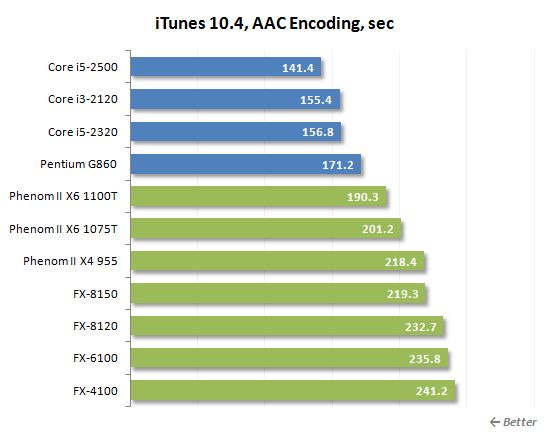
The memory sub-system speed is has serious effect on performance in applications processing large amounts of data, like the archiving tools, for example. FX processors from AMD support DDR3-1866 that is why they managed to get far ahead of their predecessors in WinRAR. However, even the eight-core FX-8150 and FX-8120 can’t catch up with Core i5. Nevertheless, the six- and quad-core Bulldozer processors do pretty well and are faster than the dual-core Sandy Bridge based Core i3 and Pentium CPUs.
We use Apple iTunes utility to test audio transcoding speed. It transcodes the contents of a CD disk into AAC format. Note that the typical peculiarity of this utility is its ability to utilize only a pair of processor cores.
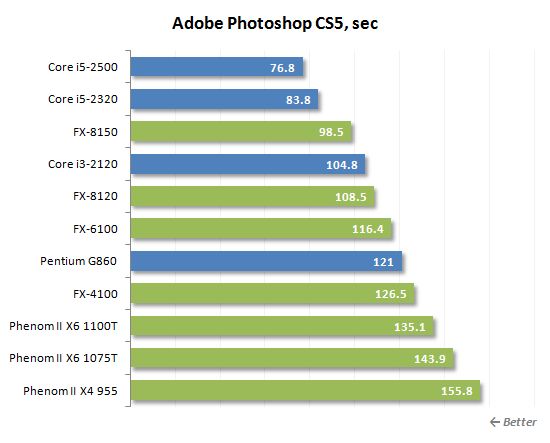
A simple operation like audio transcoding in iTunes is a serious problem for processors with Bulldozer microarchitecture. Irrespective of their price, all of them are completely defeated by Intel competitors as well as Phenom II CPUs.
We measured the performance in Adobe Photoshop using our own benchmark made from Retouch Artists Photoshop Speed Test that has been creatively modified. It includes typical editing of four 10-megapixel images from a digital photo camera.
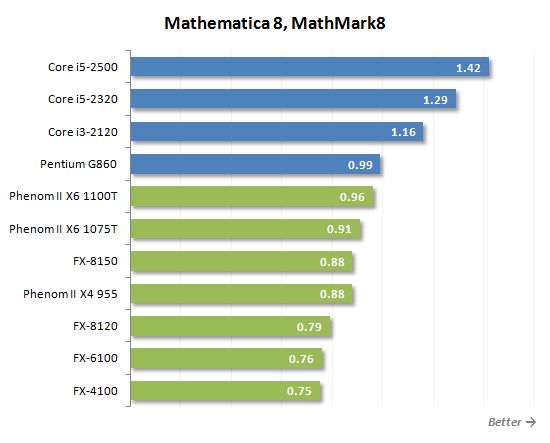
AMD FX processors do better than Phenom II in Photoshop. However, they are still unable to fully withstand Sandy Bridge’s competition. Eight-core desktop Bulldozer CPUs work as fast as Core i3, and the six- and quad-core FX-6100 and FX-4100 are about the same as the low-end dual-core Pentium.
Now that the eighth version of the popular scientific Mathematica suite I available, we decided to bring it back as one of our regular benchmarks. We use MathematicaMark8 integrated into this suite to test the systems performance:
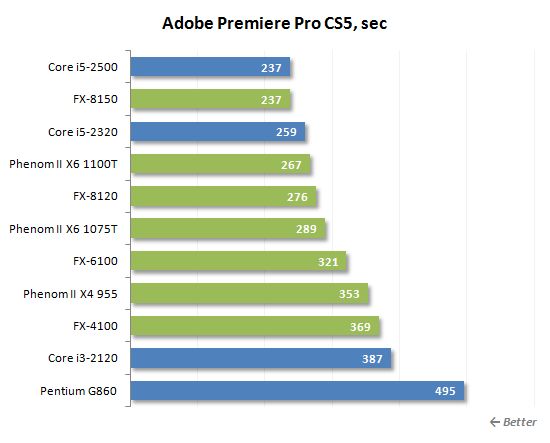
There is nothing optimistic for the new AMD CPUs in the diagram. Mathematica 8 is another example of an application in which new FX processors lose to their predecessors. Of course, competing against Sandy Bridge is completely out of the question.
The performance in Adobe Premiere Pro is determined by the time it takes to render a Blu-ray project with a HDV 1080p25 video into H.264 format and apply different special effects to it.
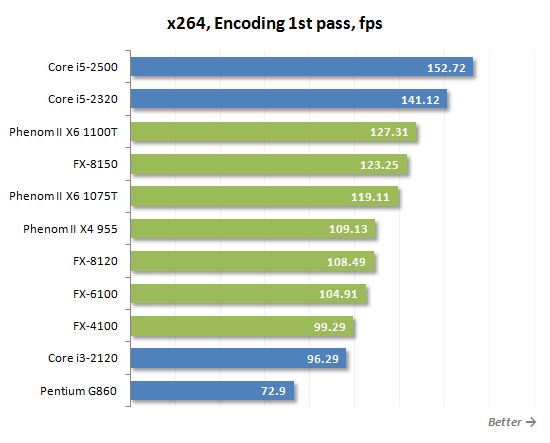
Moving on to the benchmarks dealing with HD video content processing, we expected to finally see decent performance of the new AMD processors. This was pretty much the case. Premiere pro splits the load in parallel threads perfectly and AMD’s multi-core approach finally pays off. FX-8150 runs neck and neck with Core i5-2500, and the junior FX-6100 and FX-4100 compete successfully against Core i3 products. The only disappointment is the FX-8120: its very low clock frequency makes it fall behind even the youngest Core i5 model, while its price is at a higher level.
In order to measure how fast our testing participants can transcode a video into H.264 format we used x264 HD Benchmark 4.0. It works with an original MPEG-2 video recorded in 720p resolution with 4 Mbps bitrate. I have to say that the results of this test are of great practical value, because the x264 codec is also part of numerous popular transcoding utilities, such as HandBrake, MeGUI, VirtualDub, etc.
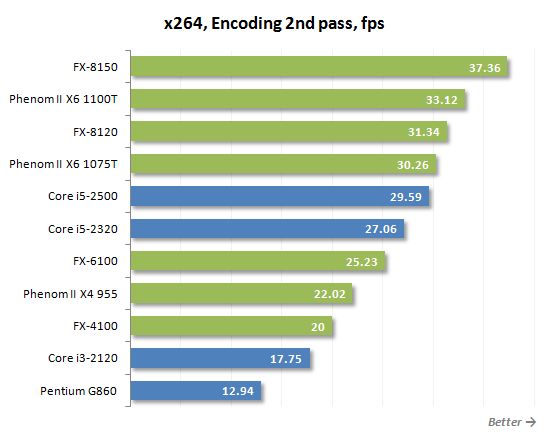
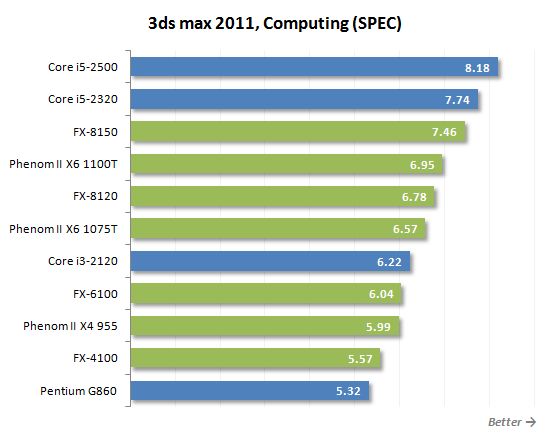
Transcoding using x264 codec seems to be the ideal application for processors on AMD Bulldozer microarchitecture. Here the eight-core FX-8150 and FX-8120 work significantly faster than Core i5 processors, while FX-6100 and FX-4100 with fewer cores fit perfectly in the gap between Core i5 and Core i3. In other words, the performance of the FX CPUs turns out even better than we have expected, considering their price.
We will test computational performance and rendering speeds in Autodesk 3ds max 2011 using the special SPECapc for 3ds max 2011 benchmark:
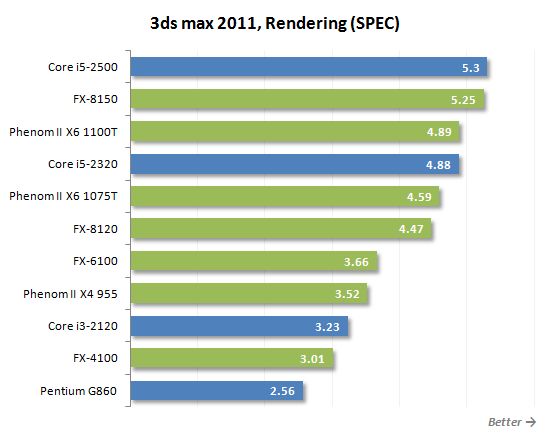
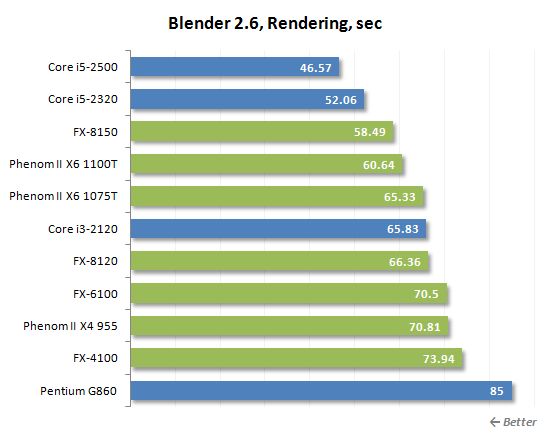
3D modeling and rendering, just like HD video processing, are also among the tasks that favor multi-core processors. Nevertheless, the results of the AMD FX processors in 3ds max 2011 are far from optimistic. Eight-core FX CPUs run as fast as Phenom II X6, and their six- and quad-core brothers are not any faster than Phenom II X4. As a result, only the top FX-8150 manages to catch up with contemporary Core i5, while FX-8120 and FX-6100 get defeated by Intel’s quad-core processors. Half of the Bulldozer processor, FX-4100, falls behind Core i3. Overall, it correlates with AMD’s current pricing, but since in many other applications the situation is much worse, we would love to see desktop Bulldozers do better than that here.
Another benchmark measuring the final rendering speed in 3D modeling suites was run in Blender 2.6.
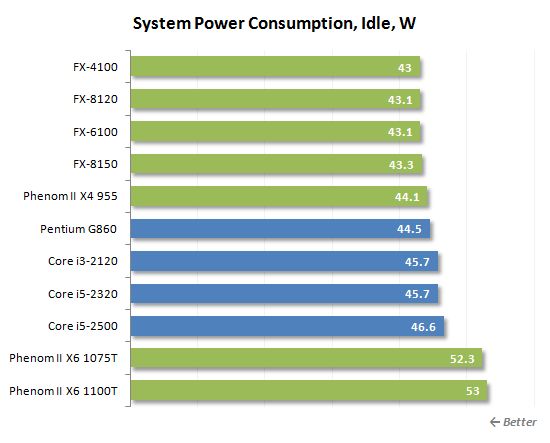
It turned out that 3ds max 2011 was in fact a Bulldozer-friendly application. Things may get much worse if we use other suites for our 3D modeling needs. And even though Blender, just like 3ds max 2011, is quite good at splitting the load into multiple threads, FX-8150 loses to quad-core Core i5, and FX-8120 and FX-6100 yield to the dual-core Core i3.
Power Consumption
Junior Bulldozer modifications do not impress us in the performance tests. However, unlike their eight-core brothers, they belong to a class of products with 95 W thermal envelope, which allows us to hope for their relative energy-efficiency. Let’s see what the practical power consumption tests will show.
The graphs below show the full power draw of the computer (without the monitor) measured after the power supply. It is the total of the power consumption of all the system components. The PSU’s efficiency is not taken into account. The CPUs are loaded by running the 64-bit LinX 0.6.4 utility. We enabled all the power-saving technologies for correct measurement of the computer’s power draw in idle mode: C1E, AMD Cool’n’Quiet and Enhanced Intel SpeedStep.
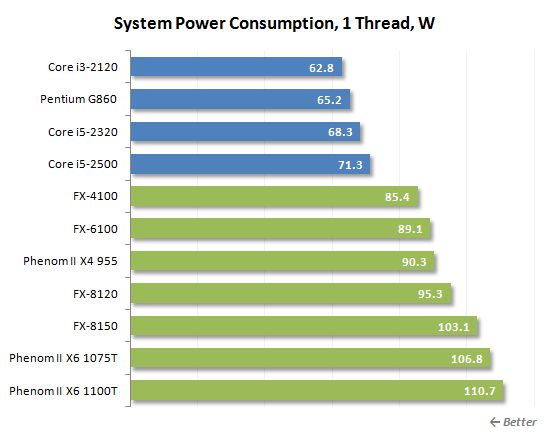
In idle mode when all processor power-saving technologies kick in platforms based on AMD FX processors look quite good in terms of their power appetites. The CPUs obviously contribute very little to the overall system power consumption in this case and the 40 W reading for the most part comes from all other system components. Therefore, the results for AMD FX, AMD Phenom II X4 and Sandy Bridge products are very similar.
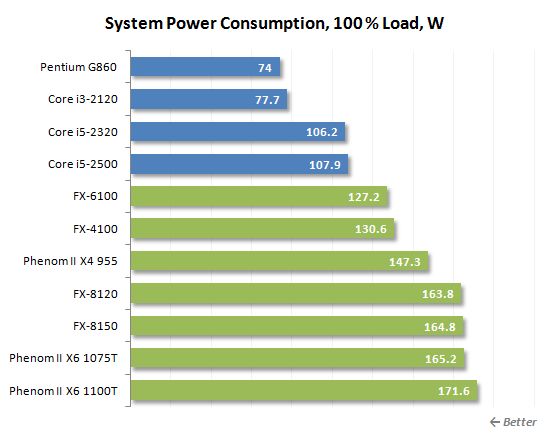
It is interesting to test the systems power consumption under single-threaded load because in this case all contemporary processors enable their Turbo mode, which boosts the performance while keeping power consumption and heat dissipation within acceptable range. Nevertheless, processor makers have different understanding of the term “acceptable range”, so different Sandy Bridge modifications prove much more energy-efficient. At the same time, the actual power consumption of AMD FX processors under single-threaded load is lower than that of their predecessors. Although as our tests showed, their performance in this case is also lower.
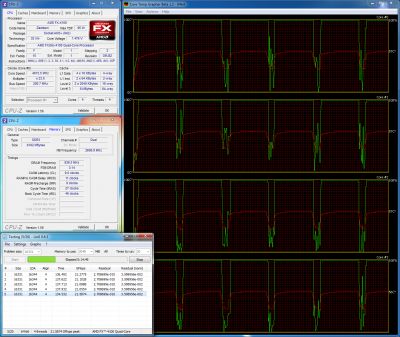
When all processor cores are fully loaded with multiple computational threads, the power consumption of eight-core 125 W AMD FX CPUs reaches that of six-core Phenom II X6 with the same declared TDP. However the actual power consumption of the junior Bulldozer modifications, FX-6100 and FX-4100, with lower declared TDP is quite naturally about 30-35 W lower. Although, this is still not enough to make the platform built on the junior Bulldozer models as energy-efficient as the competing configurations built around Intel CPUs.
Overclocking
AMD positions their FX processors as overclocking-friendly solutions. They are all marked as “Black Edition” units and have unlocked multipliers, which makes overclocking very simple. In fact, it is their only indisputable advantage over Intel Sandy Bridge. Among Intel’s products, only three LGA 1155 CPUs from the K-series overclock fully and they are priced at over $200. It means that in the sub-$200 price range computer enthusiasts can only go with AMD, primarily FX series CPUs. So, it is FX-6100 or FX-4100 that will most likely become an optimal overclocking choice.
Since we had the entire lineup of currently available AMD FX processors at our disposal, we decided to check out the overclocking potential of all four models. Note that we didn’t aim for setting an overclocking record. Our goal was different: to determine the frequency, at which desktop Bulldozer processors will be able to work stably and fault-free in 24/7 mode. Therefore, we only increased the processor core voltage by 0.1-0.15 V and used NZXT Havik 140 air-cooler for proper processor cooling. We tested the system stability during overclocking in LinX 0.6.4 64 bit utility.
We managed to increase the clock frequency of our quad-core AMD FX-4100 processor to 4.6 GHz without any stability issues. At the same time the North Bridge built into it got overclocked to 2.6 GHz. The processor Vcore was only increased by 0.1 V in this case, because our particular CPU had pretty high nominal Vcore to begin with.
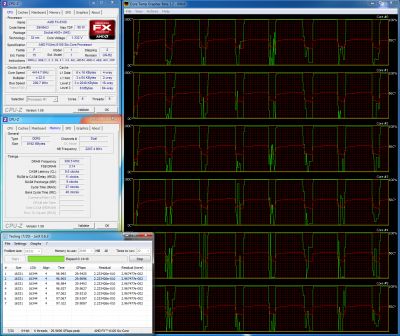
Six-core AMD FX-6100 processor revealed a slightly lower overclocking potential. Even though we raised its core voltage by 0.15 V, the highest we could go on the frequency was 4.4 GHz. As for the North Bridge built into the processor, it practically didn’t get overclocked at all: we managed to increase its frequency only by 200 MHz above the nominal – to 2.2 GHz.
The junior eight-core desktop Bulldozer processor, FX-8120, got easily overclocked to 4.5 GHz. It required 0.15 V Vcore increase to ensure stability, just like in the previous case. At the same time we managed to increase to 2.6 GHz the frequency of the North Bridge integrated into the CPU.
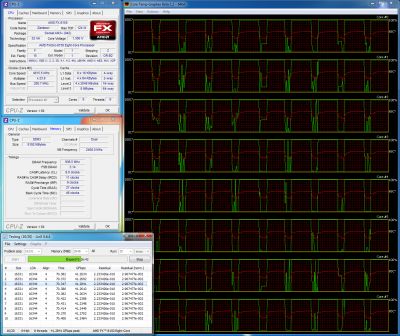
We already overclocked AMD FX-8150 processor before in our previous Bulldozer review. Back then it proved capable of working at 4.6 GHz frequency. Our today’s test session confirmed the previously obtained result. With the core voltage increased by 0.15 V above the nominal this processor remained perfectly stable at the attained frequency, with the North Bridge sped up to 2.4 GHz at the same time.
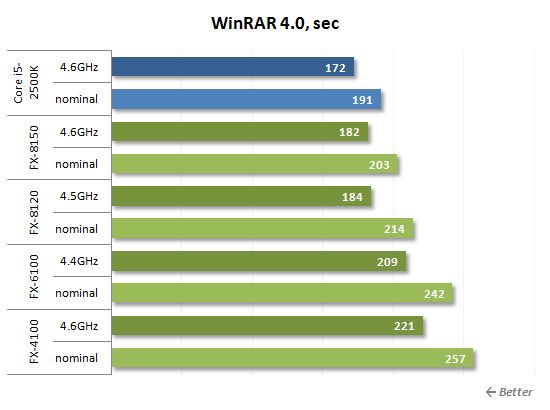
Overall, all desktop processors with Bulldozer microarchitecture demonstrated pretty similar overclocking potential. All of them could be easily overclocked to 4.4-4.6 GHz and remain stable at these speeds over a long period of time. The operational temperature of the processor cores remain within acceptable range, and do not exceed 60-65°C even for the eight-core FX CPUs with 125 W TDP.
Although these results are quite encouraging, the experiments with overclocked AMD FX processors left a very ambiguous impression. We hoped that we would be able to turn junior Bulldozer processors with reduced number of computational cores into eight-core ones by somehow unlocking the disabled cores, but to our regret AMD made it absolutely impossible, even though this function was a signature feature of all previous-generation CPUs. Therefore, the only way computer enthusiasts will be able to boost the performance of the new FX processors is by raising their clock speed.
In order to estimate the performance gain from AMD FX overclocking, we tested all four processors at the nominal and overclocked frequencies. The obtained results were then compared against the performance of Core i5-2500K in nominal mode and at 4.6 GHz frequency, which may be considered typical overclocking for this particular CPU.
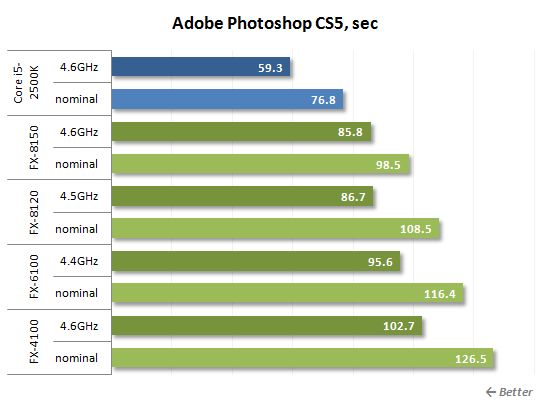
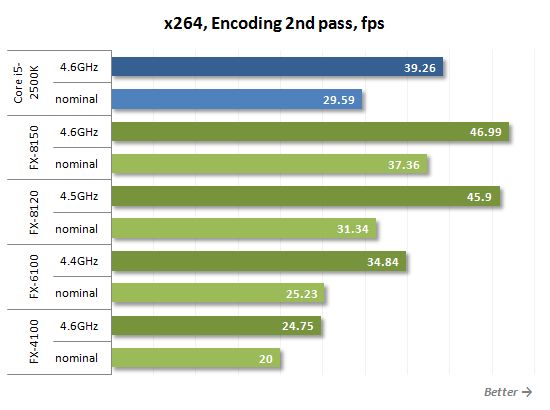
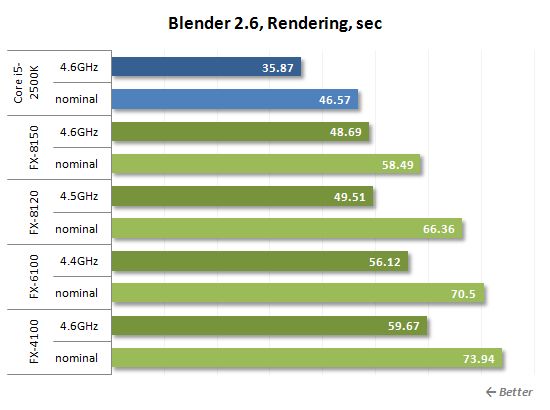
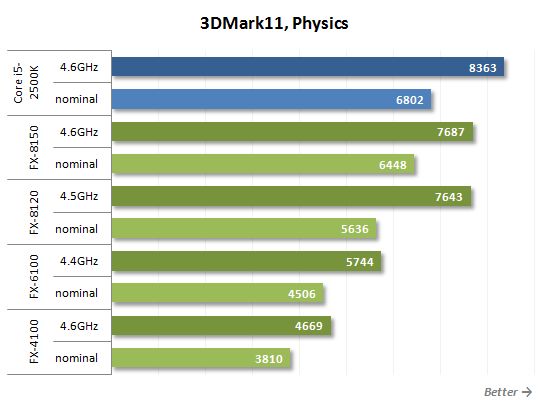
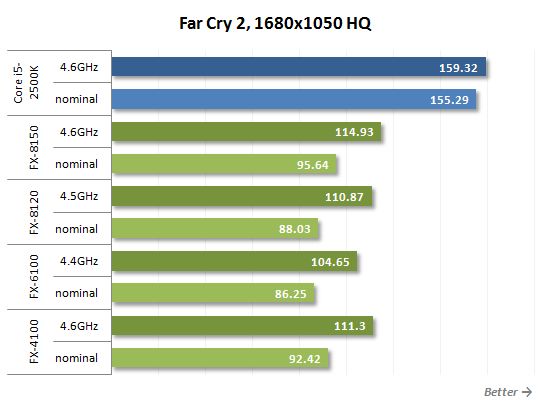
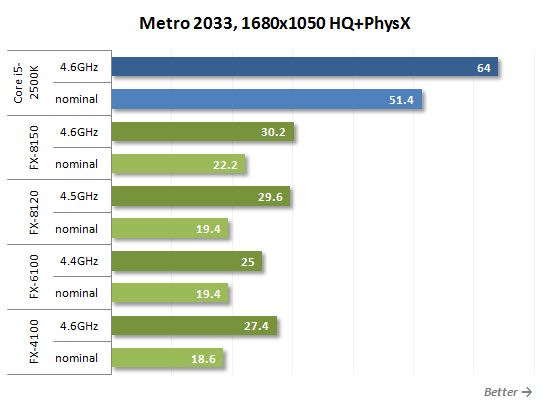
The highest performance gain results from overclocking the junior eight-core FX-8120 model. It is, in fact, quite logical, because its original clock frequency is the lowest in the entire family. However, you will notice a substantial performance improvement after overclocking any of the Bulldozer CPUs. You can count on an average 25% increase above the nominal, which is about the gain you would get from overclocking Intel’s Sandy Bridge CPUs with an unlocked clock frequency multiplier.
However, FX processors really suffer from their originally low performance. Even overclocked eight-core Bulldozer CPUs can’t always catch up in performance with a Core i5-2500K working at its nominal frequencies. And if we compare all processors in overclocked mode, the only obvious argument in favor of the AMD products for overclocking needs will be their lower price.
Conclusion
Two months ago when we tested the top desktop Bulldozer processor, we concluded that it turned out a big disappointment. The results of our today’s FX series testing, including lower-cost CPU modifications, didn’t change out opinion. Processors on Bulldozer microarchitecture with four or six cores are designed exactly the same way as their eight-core counterparts. Pairs of cores are combined into modules and share some of the resources. And even though this approach can be implemented at a lower transistor count and allows producing relatively inexpensive monolithic semiconductor dies, the actual performance-per-core drops making the final product not so well-balanced in the end. As a result, AMD can sport many processor cores, but in reality this number doesn’t mean anything. Our tests showed that a pair of Bulldozer cores can compare in performance only against one Sandy Bridge core, and only with certain allowances and only in applications that split the load in parallel threads. This is where the low performance in most applications comes from.
The flagship eight-core CPU in the FX family, AMD FX-8150, in most cases can’t catch up even with the quad-core Core i5-2500, performing well only in few selected applications for 3D modeling and during video transcoding.
Slower eight-core modification, AMD FX-8120, looks even less convincing, because it has significantly lower clock frequencies. In terms of performance, this processor ranks even below the quad-core competitor solutions. Moreover, FX-8120 is also slower than the top previous-generation AMD CPU – Phenom II X6 1100T.
Six-core FX-6100 is similar in speed to mainstream Phenom II X6 processors, and in comparison to competition, it falls between top Core i3 and junior Core i5 CPUs. Besides, in most general-purpose applications, including games, its performance is closer to that of dual-core Core i3.
The junior desktop Bulldozer CPU, FX-4100, looks more like a more up-to-date alternative to the junior Phenom II X4 processors, i.e. it is often even slower than Core i3.
Of course, performance is not the only feature of the CPU that matters to the end-users. AMD has always used pricing strategies to their advantage making their not very fast products a good buy almost all the time. However, in case of the new FX series, they seem to have lost touch with reality. Bulldozer processors are obviously overpriced, their prices are inadequate for the level of performance in general-purpose tasks that they can deliver. AMD may be betting on enthusiasts who care about energy-efficiency and who won’t be able to find an Intel product with overclocking capabilities in the sub-$200 price range. However, in our opinion this argument won’t save even the very junior FX models, especially since it is impossible to unlock the disabled cores in FX-6100 and FX-4100 CPUs.
It turns out that the only one who may benefit from the upcoming migration from Phenom II to the new FX family is AMD. Bulldozer microarchitecture allows the company to stop using old manufacturing process for their semiconductor dies and move on to the new cores with lower production cost. However, the end users won’t win in this situation. FX CPUs that are coming to replace the good old Phenom II processors are not faster or cheaper than their predecessors. Therefore, until processors on new Piledriver microarchitecture come out, the new FX are of no real interest to AMD fans and Phenom II owners. FX CPUs are also hardly appealing for the new systems: Intel’s Core i5 and Core i3 processors can offer better combination of price and performance in a wide range of tasks with only a few exceptions such as video transcoding in x264 codec and selected 3D rendering applications.
So, we can’t recommend getting involved with the new FX CPUs from AMD at least until they revise their pricing. And even though there are claims that desktop Bulldozer processors are selling pretty well, we can’t imagine who could really be investing their hard-earned cash into these products.